人教版新目标英语九年级第六单元教案设计
- 格式:doc
- 大小:32.00 KB
- 文档页数:2
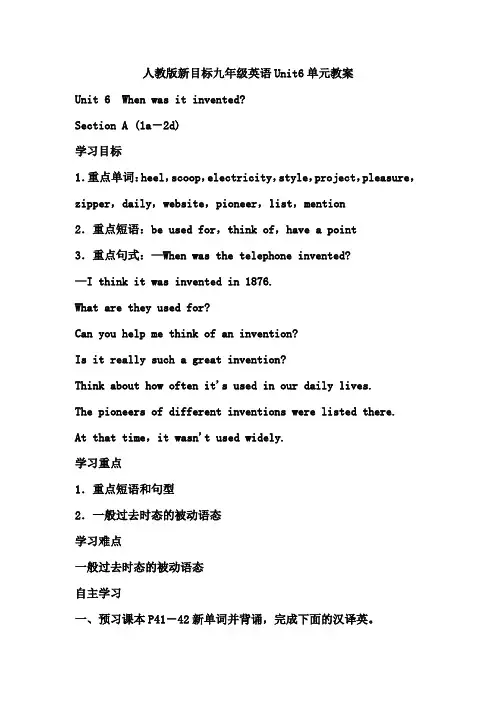
人教版新目标九年级英语Unit6单元教案Unit 6 When was it invented?Section A (1a-2d)学习目标1.重点单词:heel,scoop,electricity,style,project,pleasure,zipper,daily,website,pioneer,list,mention2.重点短语:be used for,think of,have a point3.重点句式:—When was the telephone invented?—I think it was invented in 1876.What are they used for?Can you help me think of an invention?Is it really such a great invention?Think about how often it's used in our daily lives.The pioneers of different inventions were listed there.At that time,it wasn't used widely.学习重点1.重点短语和句型2.一般过去时态的被动语态学习难点一般过去时态的被动语态自主学习一、预习课本P41-42新单词并背诵,完成下面的汉译英。
1.鞋跟________ 2.铲子________3.电能________ 4.样式________5.项目________ 6.高兴________7.拉链________ 8.日常的________9.网站________ 10.先锋________11.名单________ 12.提到________二、认真预习1a-2d找出下列短语和句型。
1.被用来……__________________________________________________________ ______________2.考虑__________________________________________________________ ______________3.有道理__________________________________________________________ ______________4.—电话是什么时候发明的?—我认为它是1876年发明的。
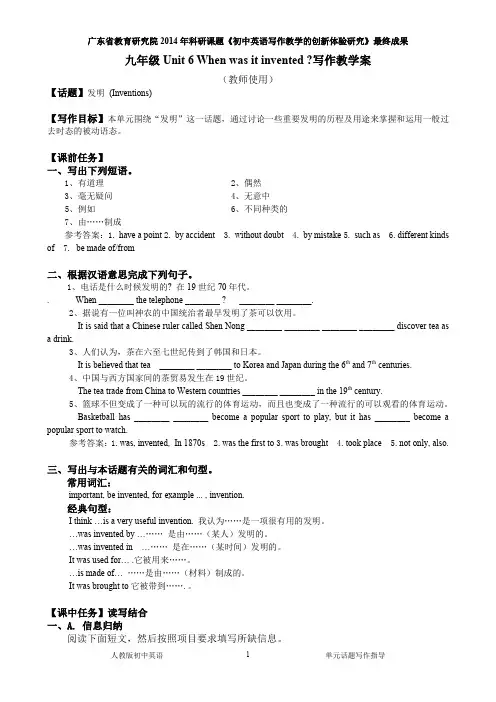
九年级Unit 6 When was it invented ?写作教学案(教师使用)【话题】发明(Inventions)【写作目标】本单元围绕“发明”这一话题,通过讨论一些重要发明的历程及用途来掌握和运用一般过去时态的被动语态。
【课前任务】一、写出下列短语。
1、有道理2、偶然3、毫无疑问4、无意中5、例如6、不同种类的7、由……制成参考答案:1. have a point 2. by accident 3. without doubt 4. by mistake5. such as 6.different kinds of 7. be made of/from二、根据汉语意思完成下列句子。
1、电话是什么时候发明的? 在19世纪70年代。
. When ________ the telephone ________ ? ________ ________.2、据说有一位叫神农的中国统治者最早发明了茶可以饮用。
It is said that a Chinese ruler called Shen Nong ________ ________ ________ ________ discover tea asa drink.3、人们认为,茶在六至七世纪传到了韩国和日本。
It is believed that tea ________ ________ to Korea and Japan during the 6th and 7th centuries.4、中国与西方国家间的茶贸易发生在19世纪。
The tea trade from China to Western countries ________ ________ in the 19th century.5、篮球不但变成了一种可以玩的流行的体育运动,而且也变成了一种流行的可以观看的体育运动。
Basketball has ________ ________ become a popular sport to play, but it has ________ become a popular sport to watch.参考答案:1.was, invented, In 1870s 2.was the first to3.was brought 4.took place 5.not only, also.三、写出与本话题有关的词汇和句型。
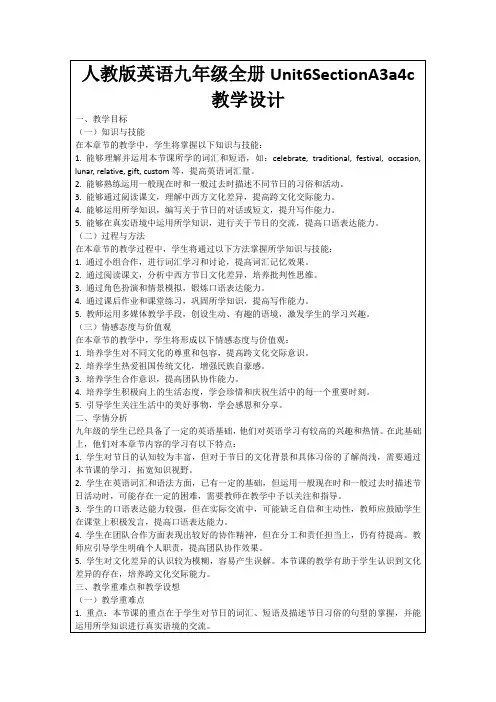
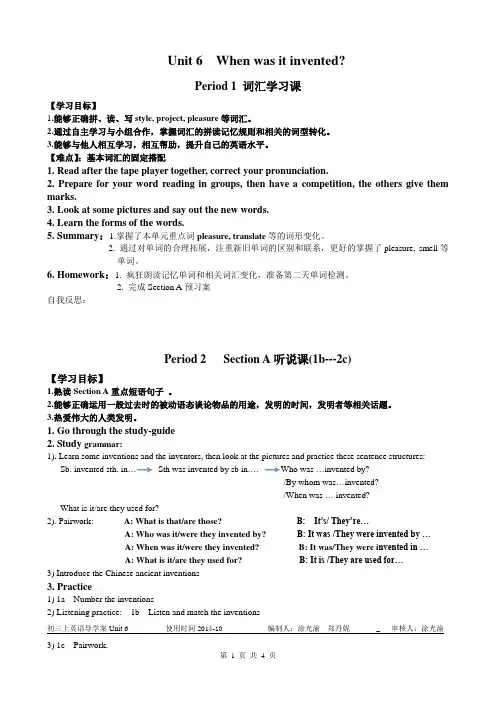
Unit 6 When was it invented?Period 1 词汇学习课【学习目标】1.能够正确拼、读、写style, project, pleasure等词汇。
2.通过自主学习与小组合作,掌握词汇的拼读记忆规则和相关的词型转化。
3.能够与他人相互学习,相互帮助,提升自己的英语水平。
【难点】:基本词汇的固定搭配1. Read after the tape player together, correct your pronunciation.2. Prepare for your word reading in groups, then have a competition, the others give them marks.3. Look at some pictures and say out the new words.4. Learn the forms of the words.5. Summary:1.掌握了本单元重点词pleasure, translate等的词形变化。
2. 通过对单词的合理拓展,注重新旧单词的区别和联系,更好的掌握了pleasure, smell等单词。
6. Homework:1. 疯狂朗读记忆单词和相关词汇变化,准备第二天单词检测。
2. 完成Section A预习案自我反思:Period 2 Section A听说课(1b---2c)【学习目标】1.熟读Section A重点短语句子。
2.能够正确运用一般过去时的被动语态谈论物品的用途,发明的时间,发明者等相关话题。
3.热爱伟大的人类发明。
1. Go through the study-guide2. Study grammar:1). Learn some inventions and the inventors, then look at the pictures and practice these sentence structures:Sb. invented sth. in…Sth was invented by sb in.…Who was …invented by?/By whom was…invented?/When was … invented?What is it/are they used for?2). Pairwork: A: What is that/are those? B: It’s/ They’re…A: Who was it/were they invented by? B: It was /They were invented by …A: When was it/were they invented? B: It was/They were i nvented in …A: What is it/are they used for? B: It is /They are used for…3) Introduce the Chinese ancient inventions3. Practice1) 1a Number the inventions2) Listening practice: 1b Listen and match the inventions初三上英语导学案Unit 6 使用时间2014-10编制人:涂光渝郑丹妮 _ 审核人:涂光渝3) 1c Pairwork.4) 2a Listen.Listen and number the inventions2b Listen again and complete the chart.5)2c PairworkA: What are they used for…?B: They’re used for…4. Summary: 通过对话和听力练习熟练掌握了一般过去时被动语态的句子结构及本单元句型:What’s it used for?When was it invented?Who was it invented by?5. Homework:1. 完成新支点的第一课时。
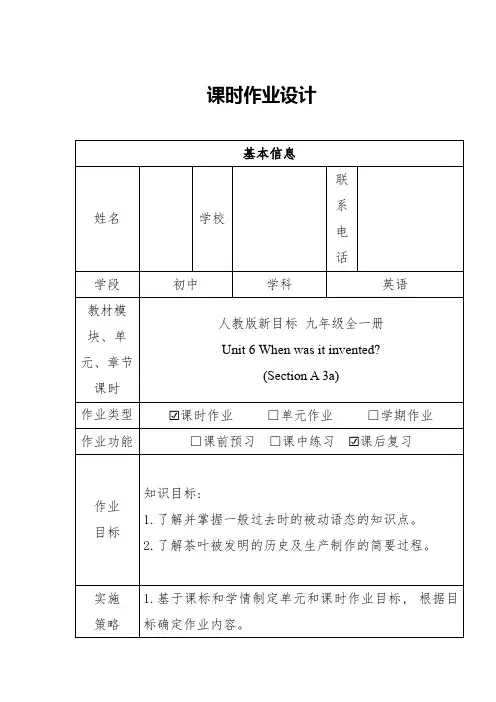
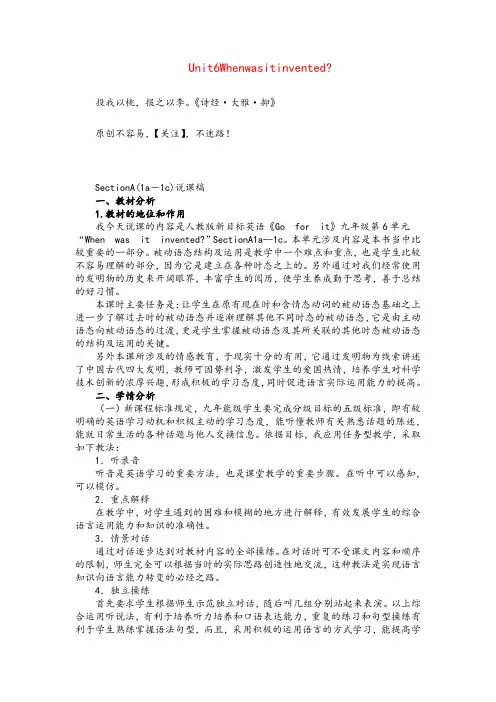
Unit6Whenwasitinvented?投我以桃,报之以李。
《诗经·大雅·抑》原创不容易,【关注】,不迷路!SectionA(1a-1c)说课稿一、教材分析1.教材的地位和作用我今天说课的内容是人教版新目标英语《Go for it》九年级第6单元“When was it invented?”SectionA1a--1c。
本单元涉及内容是本书当中比较重要的一部分。
被动语态结构及运用是教学中一个难点和重点,也是学生比较不容易理解的部分,因为它是建立在各种时态之上的。
另外通过对我们经常使用的发明物的历史来开阔眼界,丰富学生的阅历,使学生养成勤于思考,善于总结的好习惯。
本课时主要任务是:让学生在原有现在时和含情态动词的被动语态基础之上进一步了解过去时的被动语态并逐渐理解其他不同时态的被动语态,它是由主动语态向被动语态的过渡,更是学生掌握被动语态及其所关联的其他时态被动语态的结构及运用的关键。
另外本课所涉及的情感教育,于现实十分的有用,它通过发明物为线索讲述了中国古代四大发明,教师可因势利导,激发学生的爱国热情,培养学生对科学技术创新的浓厚兴趣,形成积极的学习态度,同时促进语言实际运用能力的提高。
二、学情分析(一)新课程标准规定,九年能级学生要完成分级目标的五级标准,即有较明确的英语学习动机和积极主动的学习态度,能听懂教师有关熟悉话题的陈述,能就日常生活的各种话题与他人交换信息。
依据目标,我应用任务型教学,采取如下教法:1.听录音听音是英语学习的重要方法,也是课堂教学的重要步骤。
在听中可以感知,可以模仿。
2.重点解释在教学中,对学生遇到的困难和模糊的地方进行解释,有效发展学生的综合语言运用能力和知识的准确性。
3.情景对话通过对话逐步达到对教材内容的全部操练。
在对话时可不受课文内容和顺序的限制,师生完全可以根据当时的实际思路创造性地交流,这种教法是实现语言知识向语言能力转变的必经之路。
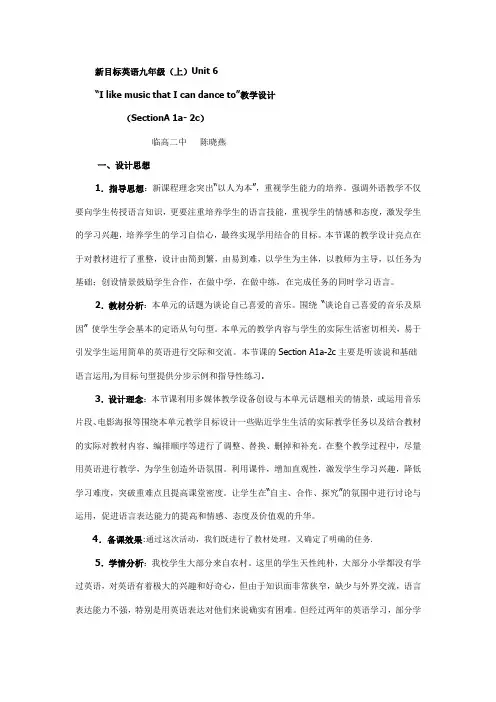
新目标英语九年级(上)Unit 6“I like music that I can dance to”教学设计(SectionA 1a- 2c)临高二中陈晓燕一、设计思想1.指导思想:新课程理念突出“以人为本”,重视学生能力的培养。
强调外语教学不仅要向学生传授语言知识,更要注重培养学生的语言技能,重视学生的情感和态度,激发学生的学习兴趣,培养学生的学习自信心,最终实现学用结合的目标。
本节课的教学设计亮点在于对教材进行了重整,设计由简到繁,由易到难,以学生为主体,以教师为主导,以任务为基础;创设情景鼓励学生合作,在做中学,在做中练,在完成任务的同时学习语言。
2.教材分析:本单元的话题为谈论自己喜爱的音乐。
围绕“谈论自己喜爱的音乐及原因” 使学生学会基本的定语从句句型。
本单元的教学内容与学生的实际生活密切相关,易于引发学生运用简单的英语进行交际和交流。
本节课的Section A1a-2c主要是听读说和基础语言运用,为目标句型提供分步示例和指导性练习.3.设计理念:本节课利用多媒体教学设备创设与本单元话题相关的情景,或运用音乐片段、电影海报等围绕本单元教学目标设计一些贴近学生生活的实际教学任务以及结合教材的实际对教材内容、编排顺序等进行了调整、替换、删掉和补充。
在整个教学过程中,尽量用英语进行教学,为学生创造外语氛围。
利用课件,增加直观性,激发学生学习兴趣,降低学习难度,突破重难点且提高课堂密度。
让学生在“自主、合作、探究”的氛围中进行讨论与运用,促进语言表达能力的提高和情感、态度及价值观的升华。
4.备课效果:通过这次活动,我们既进行了教材处理,又确定了明确的任务.5.学情分析:我校学生大部分来自农村。
这里的学生天性纯朴,大部分小学都没有学过英语,对英语有着极大的兴趣和好奇心,但由于知识面非常狭窄,缺少与外界交流,语言表达能力不强,特别是用英语表达对他们来说确实有困难。
但经过两年的英语学习,部分学生已有一定的英语自学能力,教师可利用这部分学生当“火车头”,在新课传授时起到“示范”及“引领”作用。
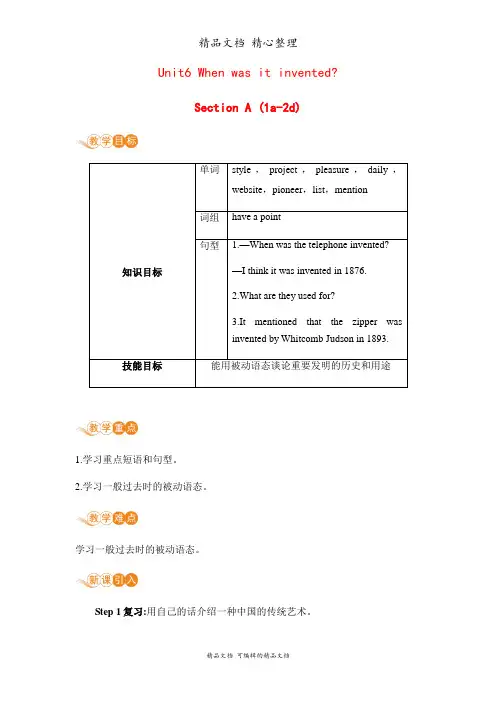
Unit6 When was it invented?Section A (1a-2d)单词style,project,pleasure,daily,1.学习重点短语和句型。
2.学习一般过去时的被动语态。
学习一般过去时的被动语态。
Step 1复习:用自己的话介绍一种中国的传统艺术。
Step 2情景导入:T:There are many useful things in the world. They help us a lot in life.(Show some pictures on the screen)Question:When were they invented?Students:1.The telephone was invented in 1876.2.The computer was invented in…环节说明:通过课前的师生问答互动引入新课的话题,通过图片展示和语言描述创设情境,激发了学生的学习兴趣。
Step 3完成教材1a-1c中的任务:1.1a中的四种发明,你认为哪个是最早被发明的,依次标出序号。
2.认真听录音,将1b中的物品和发明年代相匹配。
3.再听一遍录音,并跟读对话。
4.两人一组,利用1b中的物品和发明年代,仿照1c的对话形式编练新的对话。
5.小结训练—When the telephone ?—In 1876.A.did; inventB.was; inventedC.were; inventedD.do; invented答案:B1.The knife things.ed for cuttingB.is used for cutC.is used to cute to cut2.The thing by Jim under the bed is a teapot.A.inventedB.looked forC.foundD.found out3.The students how to use computers in class yesterday.A.were taughtB.taughtC.was taughtD.teach答案:1.C2.C3.A完成请完成《》P51对应习题本课时通过课前的师生问答互动引入新课的话题,并加入了情景预设、小游戏等课堂活动,不仅调动了学生的主动性和积极性,同时也锻炼了学生的模仿能力。
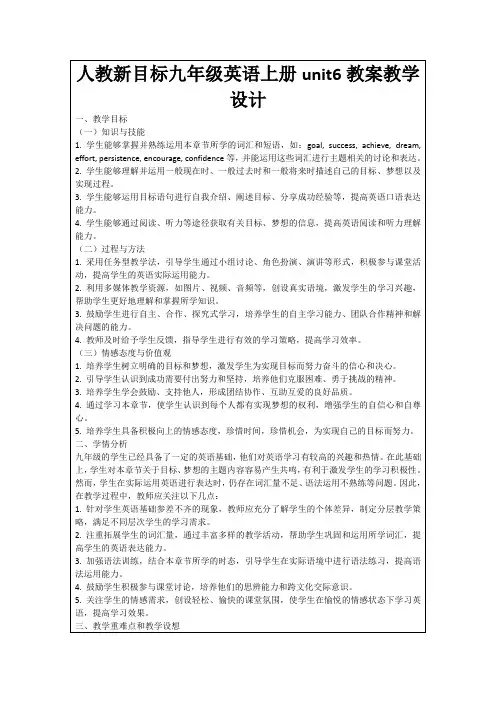
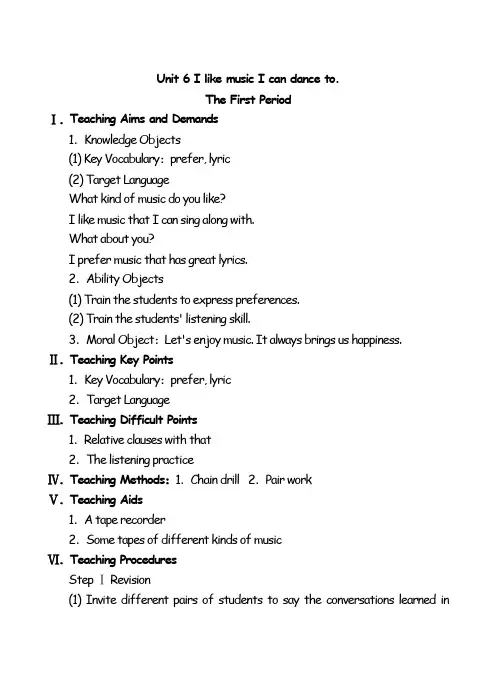
Unit 6 I like music I can dance to.The First PeriodⅠ.Teaching Aims and Demands1.Knowledge Objects(1) Key Vocabulary:prefer, lyric(2) Target LanguageWhat kind of music do you like?I like music that I can sing along with.What about you?I prefer music that has great lyrics.2.Ability Objects(1) Train the students to express preferences.(2) Train the students' listening skill.3.Moral Object:Let's enjoy music. It always brings us happiness. Ⅱ.Teaching Key Points1.Key Vocabulary:prefer, lyric2.Target LanguageⅢ.Teaching Difficult Points1.Relative clauses with that2.The listening practiceⅣ.Teaching Methods:1.Chain drill 2.Pair workⅤ.Teaching Aids1.A tape recorder2.Some tapes of different kinds of musicⅥ.Teaching ProceduresStep Ⅰ Revision(1) Invite different pairs of students to say the conversations learned inpreceding classes with books closed.(2) Check the answers to the exercises of the workbook by asking different students to say their answers to the class.(3) Dictate some of the key vocabulary words presented in units 1~5.Step Ⅱ 1aThis activity introduces the key vocabulary and trains the students to express preferences with the relative clause.Play the tapes of different kinds of music for the students, only a short piece of each tape. Say, I like music that makes me relaxed. Write these four groups of words on the blackboard, … that has great lyrics, … that I can sing along with, … that isn't too loud, … that I can dance to. Tell the students lyrics means the contents of the songs. Ask the students, What kind of music do you like?Ask the students to open their textbooks now. Read the instructions of Activity 1a to the students. Make sure they understand everything.Get the students to complete the sentence to tell what kind of music they enjoy. Ask some of the students to share their sentences. Write any new words or phrases on the board to help them if necessary.Step Ⅲ 1bThis activity gives students practice in understanding the target language in spoken conversation.Play the tape the first time and the students only listen. Then play it for a second time. The students tick in the right answer boxes. Check the answers:Step Ⅳ 1cThis activity provides guided oral practice using the target language.Read the instructions to the students. First ask a pair of the students to read the example in the box,Step Ⅴ SummarySay, In this class, first we've learned two new key words, prefer and lyrics. Then we've learned how to express references by talking about music, using relative clause with that.Step Ⅵ HomeworkAsk the students to write three sentences with I like music that …, I love music that …, I prefer music that …Step Ⅶ Blackboard Design…Unit 6 I like music I can dance to.Section AThe First Period1.sample phrases 2.Express references… that are red. I like music that …… that is big.I love music that …Sentences I prefer music that …I like flowers that are red.I like the house that is big.Relative clause with that.… that has great lyrics.… that I can sing along with.… that isn't too loud.… that I can dance to.教学反思:(二十二)2011年月日新的教学讨论方式是对传统教学方式的一种改革,但这种方式是否会带来一些教师无法控制的负面结果,如学生迷恋于网络而无心学习。
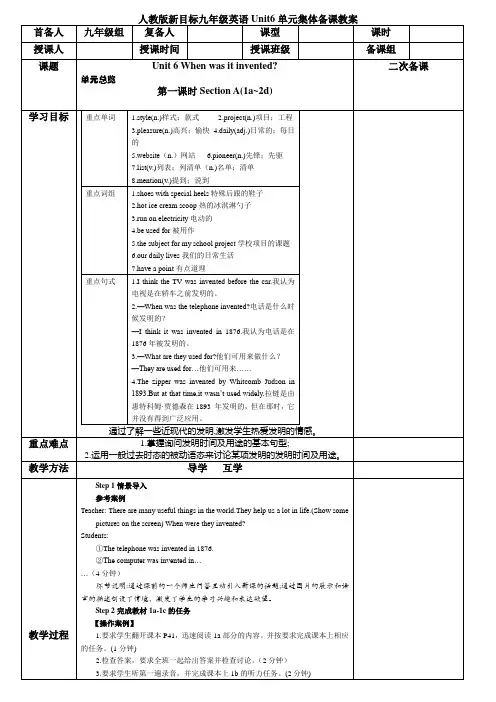
人教版新目标九年级英语Unit6单元教案Unit 6 When Was It Invented?一、单元教材分析本单元的主题是讨论历史上的发明物。
二、单元总体目标:1.知识和技能目标:1)谈论历史上的发明物。
2)掌握本单元单词和短语“be made of”、“be made in”;了解一般过去时态被动语态的结构和用法。
2.过程与方法目标:1)能够运用所学知识练被动语态的句式。
2)能够用所学句型进行口语交际练。
3.情感、态度和价值观目标:培养学生的听说演等能力及合作研究的意识。
三、单元重点:教学重点:熟练掌握“be made of”、“be made in”的运用。
四、教学难点:被动语态的运用及构成。
五、单元教学方法:采用总结、角色扮演和比较的研究策略,来展开课堂pairwork问答和讨论活动,讨论名人所采用的研究方法。
词汇教学:情景操练,反复使用。
口语教学:师生互动、生生互动、对话练、交际活动。
阅读教学:利用词典等工具书,根据上下文查寻词义。
语法教学:总结规律,模仿操练。
六、单元课时分配:6课时第1课时:n A (1a-1c)第2课时:n A (2a-2d)第3课时:n A (3a-3c)第4课时:n A (Grammar Focus-4c)第5课时:n B (1a-2e)第6课时:n B(3a-Self Check)XXX:1.To help students understand the XXX passive voice.2.To train students to use passive XXX.XXX:Step 1.Warm-upShow some pictures related to daily life and ask students to XXX voice.Step 2.nXXXXXX passive voice。
such as subject。
verb。
object。
agent。
九年级Unit 6 When was it invented?Section B (2a-2d) 教学设计Step One:Leading in 导入1Watch a piece of advertisement about mobile phone 看一段手机广告视频2 Let the Ss say the other using ways of it and get the conclusion . 学生们说出手机的一些用途,继而再说出他们眼中其他的一些发明,最终得出结论:Inventions change our life.发明改变世界设计意图:围绕本单元中心话题—发明的历史和背景,从手机的各种作用引入到各种发明给我们生活带来的改变,让学生得出结论—发明改变生活。
3 Teacher says: “Basketball is an invention too. ”Then ask Ss to say the information they knew about basketball.老师说出篮球也是一项发明,并让学生们说出自己掌握的信息。
4 Teachers show some basketball stars and the famous games of it. 老师展示篮球明星和篮球赛事的图片。
设计意图:从历史中的各种发明过度到篮球也是发明之一,让学生说说自己对篮球的了解,激活知识背景,为下一步的导入打基础。
5 Teacher asks :” Dose it have a long history?”老师问学生篮球有很长的历史吗?设计意图:学生已经了解了一些关于篮球的基本知识,但其历史信息还是空白,产生信息差,激发阅读兴趣。
Step Two:Presentation 呈现1Scan the text and match the main ideas and numbers.浏览全文并且将大意和序号连线Para One A Background(背景)(who and how) Para Two B PopularityPara Three C History设计意图:通过快速浏览,找出段落大意。
人教版新目标英语九年级第六单元教案设计
Unit 6 I like music that I can dance to.
Section A Period 1
一、教学内容分析
本单元的话题主要是谈论个人的喜好,本节课主要是让学生运用定语从句来介绍自己喜欢的音乐类型。
音乐无国界,进而谈论和我们日常生活密切联系的话题。
二、学情分析
大部分学生热爱英语,喜欢用英语来表达自己的观点和想法,本课的话题与生活实际联系较为密切,能够锻炼学生运用英语进行交际的能力。
三、教学设计说明
本课通过不同种类的音乐,谈论学生自己的喜好,主要是应用定语从句这一语法,可以说,本节新课是对这一语法的具体操练。
本课使用多媒体课件教学,用不同类型的音乐的图片、乐曲来吸引学生,激发学生学习的积极性。
同时,能让音乐这门无国界的语言愉悦学生的心灵。
Topic Unit 6 I like music that I can dance to . (Section A Period 1)
Time Sep 7. 学校吉林省洮南市蛟流河中学教师魏晓国Class 1,Grade 3
Teaching aims Knowledge
objects
1. Key vocabulary :
The students can master the words:prefer ,lyric
2. Target language :
The students can use the sentences in this period to talk about
their likes. Eg:
I like music that I can dance to./sing along with .
I prefer music that has great lyrics.
I like that music that isn’t too loud .
Ability objects 1. Train students to express preferences.
2. Train students’ listening skill. Be able to listen to the languages
about music.
Emotion objects Let’s enjoy music. It always brings us happiness.
Important points They can learn:
New words.
Target language.
Difficult points Express preferences.
The listening practice.
Task activities Task 1: Make up conversations.
Task 2 : Group work。
( Sing or dance accoring to the different kinds of music.)
Teaching steps Step 1: Leading-in
Talk about the weather and the music .
T:Good weather, good mood. Listening to music can bring us good mood .Do you think so ?
Ss: Yes.
T:OK. What kind of music do you like ? Please tell me.
S1:I like Pop music.
S2: I like Rap music.
S3: I like folk music.
….
T: Right.Now, let’s go into today’s study,we can learn more about music.
Step 2: Presentation
1) Look at the screen. It shows some pictures anout famous singers,and they
belong to different kinds of music.
The students are interested in the singers.
They talk about them as much as possible.
When they talk,the teacher explain some words and sentences.
2) 1a .Read the instructions to the class.
3) Learn the new words and target language. Finish 1a.
Step 3: Practice
1) Finish 1c .
2) Make up conversations .(Task 1)
Practice and help the students master the words and expressions.
The students can make the conversations. They can describe the music they like. Encourage them to speak more.
Step 4: Listening .
Finish 1b.
Step 5 : Task 2.
Practice and group work.. Talk about some topics in our real life .
The teacher give four kinds of music ,and the students in each group help each other. Some students talk about music they like,some sthdents listen to the music that the teacher play and act it out or sing it aloud
The students are very happy . They can sing ,they can dance, they can speak.
Step 6 : Make a summary.
Step 7: Homework
1) Remember the new words.
2) Write down sentences about music as many as you can .
Blackboard design Unit 6 I like music that I can dance to.
The words and some sentences.
After teaching。